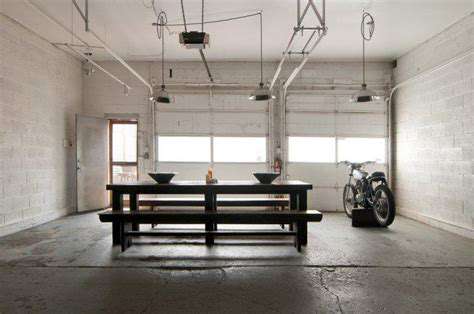How to combine metal and wood furniture in industrial designs
Metal and wood have a long and storied history of harmonious coexistence in design. Their contrasting textures and inherent qualities, from the cool, smooth sheen of metal to the warm, natural grain of wood, create a captivating visual interplay. This blend of materials can evoke a wide range of aesthetics, from rustic charm to modern sophistication, making them a popular choice for furniture and interiors.
Considering the Style of Your Space
The style of your room plays a crucial role in determining the ideal metal and wood combinations. A modern, minimalist living room might benefit from sleek, polished metal accents paired with light-toned, subtly patterned wood. A rustic farmhouse design, on the other hand, could feature wrought iron or hammered metal pieces juxtaposed against the warmth of reclaimed wood. Understanding the overall design direction helps guide the selection of specific metal and wood types.
Matching Metal Finishes to Wood Tones
The finish of the metal should complement the wood's tone. A warm, golden bronze metal will look stunning against a rich walnut or cherry wood, creating a luxurious and inviting atmosphere. Conversely, a cool, brushed stainless steel will work well with lighter woods like maple or ash, providing a clean, contemporary look. The contrast between the finishes is key to achieving visual balance.
Exploring Wood Types for Different Effects
The type of wood significantly influences the overall feel. Hardwoods like oak and maple offer strength and durability, ideal for furniture that will see regular use. Softer woods like pine or fir are often used for more affordable pieces, and their light tones can create a brighter, more airy feel. Consider the specific wood type when determining its ability to withstand wear and the overall aesthetic you're aiming for.
Functionality and Practicality in the Mix
When selecting metal and wood combinations, consider the intended function of the piece. A sturdy metal frame with a warm oak tabletop provides a strong base for a dining table, while a delicate metal stand with a light-colored wood sculpture adds a touch of elegance to a living room display. Functionality should always be a key consideration in any design choice.
Durability and Maintenance Factors
Different metals and woods have varying levels of durability and maintenance requirements. Metals like stainless steel are very resistant to corrosion and require minimal maintenance, while wrought iron might need occasional repainting to maintain its appearance. Likewise, some hardwoods like oak are more resistant to scratches and dents than softer woods like pine. Understanding these factors ensures you make informed choices based on your lifestyle and available resources.
Budget-Friendly Options and Creative Alternatives
While high-quality metal and wood combinations can be costly, several budget-friendly options exist. Mixing solid wood with metal accents, like using a metal base for a wooden coffee table, can bring a sophisticated touch without breaking the bank. Creative alternatives might include reclaimed wood for a rustic appearance or using painted metals to create a customized aesthetic. There are many avenues to achieve the desired look without a huge financial commitment.

Creating Visual Balance with Proportions and Scale
Understanding Proportional Relationships
In the realm of interior design, particularly when blending metal and wood, understanding proportional relationships is paramount to achieving visual harmony. This involves considering the relative sizes of different elements within a space, and how they relate to each other. For example, a large, imposing metal piece, like a wrought iron bed frame, needs to be balanced by surrounding elements, perhaps a set of smaller, more delicate wooden side tables, or a strategically placed wooden headboard to provide a sense of visual equilibrium. Proper proportioning ensures that no single element overwhelms the others, creating a cohesive and aesthetically pleasing design.
Achieving a sense of scale is just as important. Think about the overall size of the room. A substantial wooden coffee table in a small living room might feel out of place, while a similarly sized table in a large, open-plan space can feel appropriate. The scale of both metal and wood pieces needs to be thoughtfully considered in relation to the room's dimensions and the overall flow of the design.
Applying Scale and Proportion in Metal and Wood Combinations
When combining metal and wood, the choice of scale and proportion can dramatically impact the overall aesthetic. A minimalist approach might feature sleek, modern metal accents alongside a solid, rustic wooden piece, like a large wooden chest. Conversely, a more traditional look might use ornate metal hardware on a heavily detailed wooden cabinet. The key is to ensure that the visual weight of each material complements the other, creating a unified and balanced look rather than a chaotic assortment of contrasting elements.
Consider the lines and shapes. A geometrically shaped metal object can work beautifully with a piece of wood with organic shapes, creating a dynamic interplay. The interplay of these two contrasting elements—smooth metal and the warmth of wood—can create a compelling aesthetic. You need to play with different shapes and sizes within each material to bring out the best of both.
An ideal solution might involve incorporating smaller, more refined metal details, such as decorative knobs or light fixtures, on a piece of larger wood furniture. Such careful consideration of proportions creates a visually appealing, unified design. Think about how different textures, like the polished sheen of a metal accent versus the natural grain of wood, add depth to the space.
A skilled designer always carefully considers the impact of scale and proportion on the visual balance of any space, especially when blending metal and wood. It's not just about the size, but also the shape and texture of the elements involved.
Highlighting the Texture and Pattern Play

Exploring the Intricate Details of Fabric Textures
Fabric textures play a crucial role in the overall aesthetic appeal and feel of garments, home decor, and various other products. Understanding the different types of textures, from the smooth elegance of silk to the rugged charm of linen, is essential for appreciating the artistry and craftsmanship behind these materials. Exploring these textures allows us to connect with the unique characteristics of each fabric, recognizing how they contribute to the final product's visual and tactile experience. Different weaves and finishes significantly impact the way light interacts with the fabric, resulting in a spectrum of visual effects.
Furthermore, the tactile sensation of a fabric is equally important. A soft, plush texture is ideal for comfort, while a crisp, structured texture lends a sense of sophistication. Understanding these tactile variations allows us to make informed choices about which fabrics best suit specific needs and applications. The ability to appreciate the intricate details of these textures adds a layer of depth and appreciation to the design process.
Unveiling the Patterns in Textiles
The patterns woven into fabrics add another dimension to their visual appeal. From subtle stripes to bold florals, patterns can transform a simple piece of clothing or home furnishing into a statement piece. Examining the interplay of colors and shapes in these patterns reveals the creativity and skill of the textile artists. Patterns are often selected to create a specific mood or visual effect, influencing the overall impression of a room, outfit, or product.
The choice of pattern can also be highly influential in creating a particular ambiance. For example, a bold geometric pattern can lend a modern feel, while a delicate floral pattern can evoke a sense of tranquility and warmth. The skillful arrangement of these patterns adds another dimension to the artistry of textile design, often conveying a symbolic meaning or cultural significance.
The Impact of Texture on Perceived Value
The texture and pattern of a fabric can significantly influence how it is perceived. A luxurious, high-quality fabric with a unique texture often commands a higher price point compared to a fabric with a more basic texture. Understanding this connection allows consumers to make informed purchasing decisions, understanding the correlation between quality and appearance. Skilled artisans frequently manipulate textures and patterns to create an impression of greater quality, and value to their craft.
The perceived value of a fabric also often relates to its perceived utility. A soft, comfortable fabric might be valued for its practicality in everyday wear, while a luxurious, intricate fabric may be valued for its aesthetic appeal and ability to elevate the appearance of a piece of furniture. High-quality materials provide a superior user experience and often translate into increased product longevity.
The Role of Texture and Pattern in Design
Texture and pattern are fundamental elements in design, influencing the overall aesthetic, feel, and functionality of a product. Designers use these elements strategically to create a visually appealing and engaging experience. The interplay of textures and patterns impacts not only the appearance but also the perceived quality and feel of a product.
The ability to manipulate textures and patterns allows designers to create specific moods and atmospheres. For instance, a rough texture paired with a bold pattern might suggest a rugged or rustic aesthetic, whereas a smooth texture and delicate pattern may evoke a sophisticated and refined look. These design choices often reflect cultural influences, personal preferences, and evolving trends. The ability to understand and appreciate these design elements greatly enhances one's ability to engage with and critique artistic expressions.